A wireless keyboard is a device that transmits input information to a special receiver through infrared or radio waves without a direct physical connection between the keyboard body and the computer. Specifically, it is a Bluetooth device. The so-called Bluetooth technology is actually a short-range radio technology. Using “Bluetooth” technology can effectively simplify communication between handheld computers, laptops, mobile phones, and other mobile communication terminal devices. In most cases, there is no difference between using a keyboard with a wireless connection and a keyboard with a standard wired connection. The only thing you will notice is when you should charge it or forget to charge it. Today, we talk things you should know when purchasing wireless keyboards.

Wireless Keyboards Purchasing Guide – How To Choose Your Wireless Keyboard
The wireless keyboard (and wireless mouse) also uses two main technologies to connect devices: Bluetooth or 2.4GHz radio frequency (RF) connection. The latter connects to your device via a USB dongle. Bluetooth models assume that your host supports Bluetooth, or that you have your own Bluetooth dongle. Each connection type has its own advantages and disadvantages.
In modern keyboards, 2.4GHz RF provides a stable connection and sometimes provides almost imperceptible typing delay. If the desktop or notebook computer has built-in support for these keyboards, you need to plug the USB dongle into the USB port.
Bluetooth’s connection is reliable, but it is more prone to delay and/or instantaneous connection loss, especially when you have many Bluetooth connections in a place (such as an office or coffee shop). Bluetooth also tends to consume the battery of the keyboard faster.
The basic principle of purchasing a keyboard
Compared with a wired keyboard, there is no difference between selecting a standard wired keyboard and a wireless keyboard except for connectivity and battery life. Then you can choose from the following aspects.
Key layout
Most wireless keyboards are full-size, which means they have 104 or more keys, including numeric keyboards. The most production-oriented models use low-profile scissor keys, similar to the keys you see in laptops. This keeps them slim in size and makes them lighter. With this in mind, the best wireless keyboards do not emphasize aesthetics so much that the buttons feel too tight.
Additional features
Generally speaking, wireless keyboards often have some daily functions, such as dedicated media and macro keys. Some keyboards such as Logitech’s high-end keyboards also have the function of connecting to multiple devices and switching between them by pressing a button. The game keyboard will have the same media and macro privilege suite, some of which include customizable RGB lighting and advanced configuration software.
Like the standard keyboard, the mechanical keyboard usually has a better typing feeling and better manufacturing quality than the membrane switch keyboard, but the price is also much more expensive. The two main advantages of a wireless mechanical keyboard are its more decisive feedback and longer travel, both of which make typing more confident. In addition, if you like the knocking sound of the keyboard, the mechanical keyboard will make more noise, and in some cases will make a more attractive sound.